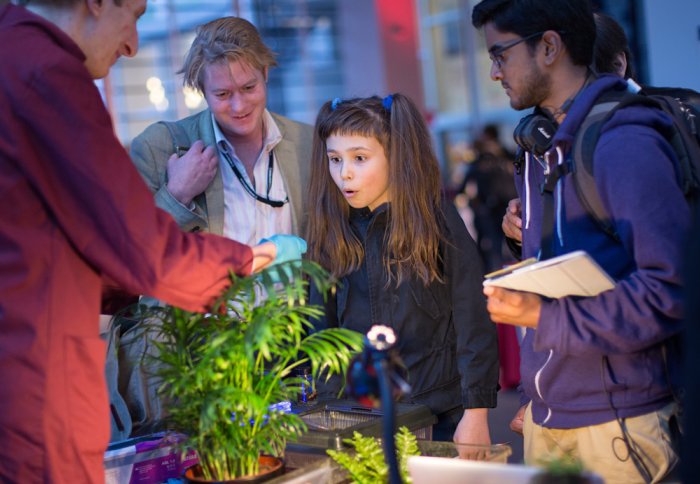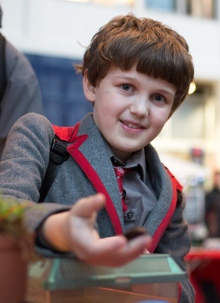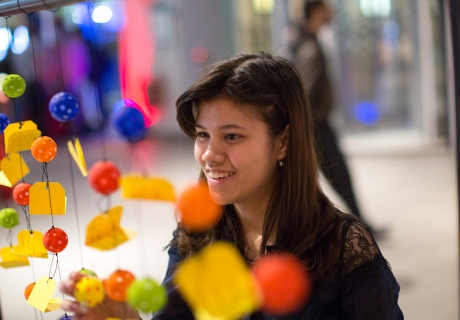

Feathers, claws and slimy scales were all on show at Thursday night's Fringe event exploring species past and present, on earth and beyond.
The species on show came in all shapes and sizes, from the gigantic to the microscopic. This final Imperial Fringe event before the 2014 Imperial Festival gave people the opportunity to ask scientists how species affect our everyday life.
Does only earth have life?
In our gigantic universe, with an estimated septillion stars (that is a mind boggling 1,000,000,000,000,000,000,000,000 stars), it is hard to imagine that there is no other life out there in the blackness of space. Dr Matthew Genge from the Department of Earth Sciences and Engineering brought along four and half billion year old meteorites to demonstrate how life may have been brought to earth.
It feels cold and smooth, but it’s tickly. I really like it, I want one!
– Etienne (nine years old)
Fringe-goer, touching a millipede
He said: “About four and half billion years ago our planet was bombarded by meteorites, which contain a lot of carbon and the biological material needed for life to begin. The early history of Mars was very similar to Earth - it was also bombarded by the same molecules - so it is very possible that there was life on Mars. We also know that there is an ocean below the surface of Jupiter’s Europa moon. The conditions there could be right for life, so who’s to say there are not mermen in Europa’s sea?”
Matthew’s Menagerie
 This exhibit saw brave children, and not so brave adults, get up close and personal with scorpions, giant millipedes and axolotls (Mexican Salamanders) in a hands-on experience. Etienne (pictured left) and Louis, aged nine and ten, stopped in to see the Fringe show with their mum on the way home from school. When Matthew Speight, Biology Project Assistant, asked if they wanted to hold a giant millipede, they boldly nodded their heads and stuck out their hands. Completely unafraid, Louis said: “it feels cold and smooth, but it’s tickly. I really like it, I want one!”.
This exhibit saw brave children, and not so brave adults, get up close and personal with scorpions, giant millipedes and axolotls (Mexican Salamanders) in a hands-on experience. Etienne (pictured left) and Louis, aged nine and ten, stopped in to see the Fringe show with their mum on the way home from school. When Matthew Speight, Biology Project Assistant, asked if they wanted to hold a giant millipede, they boldly nodded their heads and stuck out their hands. Completely unafraid, Louis said: “it feels cold and smooth, but it’s tickly. I really like it, I want one!”.
Digging for dinosaurs
Visitors stepped back in time with Junior Research Fellow Dr Susie Maidment who brought 140 million year old dinosaur bones along that were found in West Sussex by Ardingly College only a few months ago. On her popular stall, Dr Maidment explained to fascinated fringe-goers: “if Ardingly College had not been excavating at their school, we would never have had the opportunity to investigate these fossils, as they are normally unreachable in urban areas. We have been working with the school to collect and catalogue as many of these ancient fossils as possible so that we can try to build up a picture of what life was like 140 million years ago”.
Global challenges
Elsewhere, undergraduate students from the Imperial Horizons course ‘Visualising Global Challenges’ explored how science and species play a critical role in the development and protection of civilisation. In one experiment students used red stickers to infect visitors with ‘fringe fever’ to explain how quickly infectious disease can spread through human populations. In another experiment, students explored the ‘tug of war’ between comfortable living and biodiversity, asking Fringe-goers to think about what products they might be willing to give up in order to safeguard global forests. Using viruses to cure disease was the focus of another exhibition, where students used wires, webs and magnets to help visitors find what viruses could potentially cure disease.

Mariana Popa, second year biomedical science student, exploring how viruses could cure disease
Mariana Popa’s interactive exhibition on water management saw visitors taste different bottled drinking water to encourage them to think about the different chemical species that could be in water because of different water management systems. Speaking about her involvement in the Global Challenges course, Mariana said: “It has been really fun being part of this course. It has given me an opportunity to cutting edge science outside of my field, but also pushed me to do fun and creative things that I never thought I could do, like drawing art to explain science. I never thought I would be good at art!”
Visualising Global Challenges is coordinated by Senior Teaching Fellow Dr Elizabeth Hauke. “I’m really proud of the students’ work tonight. They have really stepped up to the mark. They have spent a lot of time thinking about how to communicate the science to all sorts of different people, whether they are kids, adults, students, scientists and I think that has really shown through. They have managed to extract the importance of science, but still make it fun and engaging.”
Article text (excluding photos or graphics) © Imperial College London.
Photos and graphics subject to third party copyright used with permission or © Imperial College London.
Reporter
Gail Wilson
Communications and Public Affairs

Contact details
Email: press.office@imperial.ac.uk
Show all stories by this author




Leave a comment
Your comment may be published, displaying your name as you provide it, unless you request otherwise. Your contact details will never be published.